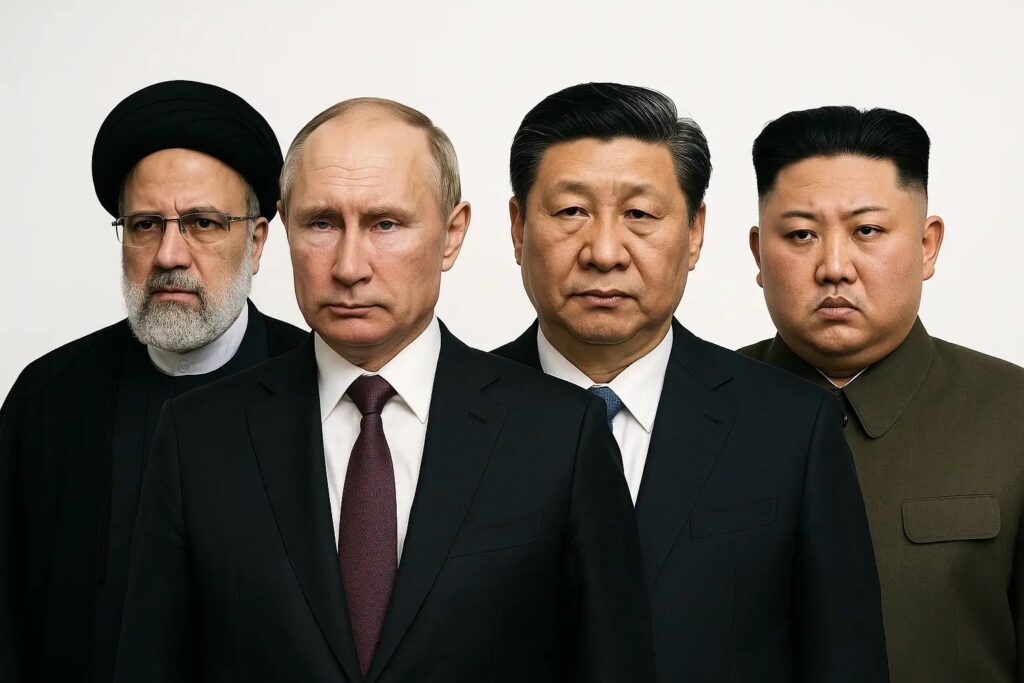Introduction: A New Power Bloc Emerges
In the shadow of declining Western influence and escalating global tensions, a new alliance has silently emerged—one that challenges the post-World War II order. Dubbed the “Axis of Upheaval,” this informal coalition includes Russia, Iran, China, and North Korea, and it represents a shift away from U.S.-led global dominance toward a multipolar and more chaotic world.
While not a formal pact, this axis is bound by mutual opposition to the West, authoritarian governance, military ambition, and strategic coordination across continents. The question is no longer if the world is changing—but how fast this shift is destabilizing the global order.
What Is the ‘Axis of Upheaval’?
The term “Axis of Upheaval” is a modern reinterpretation of historical alliances that threaten the established balance of power. The original “Axis” in World War II described a pact of aggressive powers challenging the Allies. Today, the Axis of Upheaval is a loose but powerful alignment of nations with shared anti-Western goals and a willingness to use force, propaganda, and economic disruption to achieve them.
Who Are the Key Players?
1. Russia – Aggressive in Ukraine, challenging NATO’s borders, and pushing for a Eurasian power structure.
2. China – Dominating the South China Sea, eyeing Taiwan, and building global influence through BRICS and Belt & Road.
3. Iran – Spreading influence through proxy wars in the Middle East, nuclear ambitions, and hostility toward Israel.
4. North Korea – Constant nuclear provocations and cyber warfare, backed quietly by China and occasionally Russia.
These nations are not allies in the traditional sense, but their coordination and shared objectives mark a dangerous transformation in global politics.
The Goals of the Axis of Upheaval
1. Undermining the Western Order
From NATO to the U.N., these countries challenge Western-led institutions, viewing them as tools of American imperialism.
2. Asserting Regional Dominance
Each member seeks uncontested power in its own sphere: Russia in Eastern Europe, China in the Indo-Pacific, Iran in the Middle East, and North Korea on the Korean Peninsula.
3. Weaponizing Energy and Trade
By controlling oil (Iran), gas (Russia), rare earth minerals (China), and shipping threats (North Korea), this axis seeks economic leverage over the West.
Tactics of Global Disruption
Hybrid Warfare
The Axis does not rely only on traditional battles. They employ cyberattacks, disinformation, proxy militias, and economic sabotage to weaken enemies.
- Russia’s use of Wagner mercenaries in Africa.
- Iran’s Hezbollah and Houthi forces.
- China’s digital espionage and economic coercion.
- North Korea’s ransomware attacks.
Military Demonstrations
Each country is increasing military drills and arms displays, from Russia’s hypersonic missiles to China’s aircraft carriers, creating regional panic and forcing neighbors to militarize in response.
Impact on Global Alliances
NATO Stretched Thin
With Russia in Ukraine and threats in the Baltics, NATO faces its most intense pressure since the Cold War.
Middle East Tensions
Iran’s growing confidence and missile capabilities have pushed Israel to consider preemptive strikes, dragging the U.S. and Gulf States into complex calculations.
Asian Flashpoints
Taiwan remains a potential powder keg. North Korea’s tests and China’s ambitions raise fears of a multi-theater war involving the U.S., Japan, and Australia.
H2: How the Axis Is Winning the Narrative War
The Axis of Upheaval invests heavily in propaganda and media influence:
- Russia Today (RT) and Iran’s Press TV push anti-Western stories globally.
- Chinese apps and platforms silently influence opinion in Africa, Asia, and South America.
- Social media campaigns originating from state actors destabilize democratic elections.
The soft war of ideas is just as dangerous as the hard war of bombs.
H2: Economic Implications
While the West imposed sanctions, the Axis responded with:
- New banking systems to bypass SWIFT
- Oil deals in yuan and rubles
- Massive gold reserves and BRICS expansion
This poses a serious challenge to the U.S. dollar’s global dominance, threatening long-term Western economic control.
H2: Why the Axis of Upheaval Is More Dangerous Than Past Alliances
1. Nuclear Capabilities
Russia, China, and North Korea all have nuclear arsenals. Iran is believed to be close. This increases the risk of miscalculated escalation.
2. Technological Warfare
The cyber capabilities of China and North Korea can cripple infrastructure—without firing a bullet.
3. Energy Blackmail
With Europe’s dependence on Russian gas and China’s grip on supply chains, the West is deeply vulnerable to economic disruption.
H2: What Can the West Do?
The United States and allies face a historic challenge. Possible strategies:
- Revive manufacturing to reduce dependence on China.
- Strengthen alliances in the Global South (Africa, Latin America).
- Increase military readiness and cybersecurity.
- Use AI-driven intelligence to predict and counter hybrid threats.
Failure to adapt may lead to a divided world, locked in a prolonged cold—or even hot—conflict.
Conclusion: A Global Turning Point
The Axis of Upheaval is not just a new alliance—it’s a symbol of a world sliding into chaos. As Western democracies falter under internal division, authoritarian regimes are rising with strategic clarity and ambition.

